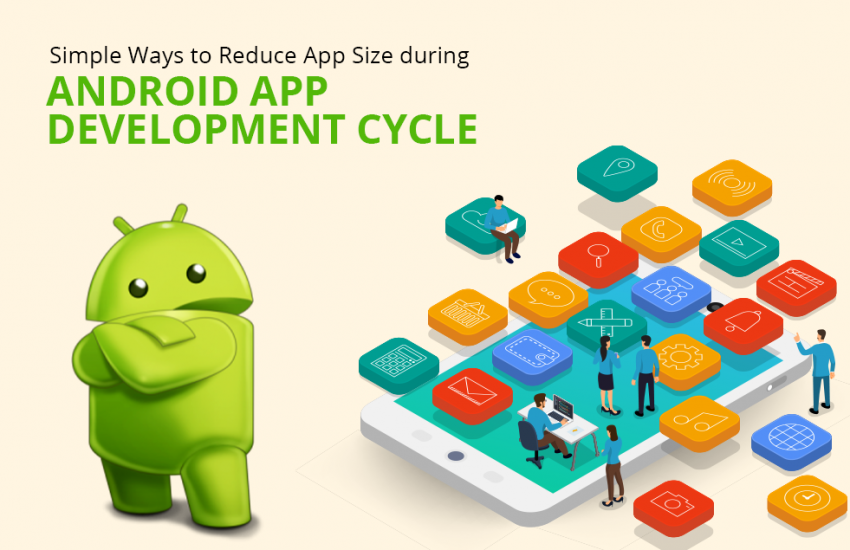How Can App Size Be Reduced while Android App Development?
The responsibility of app developers has increased manifold because human desires are not finite. To fulfill users’ increasing needs, developers must incorporate many features into one app. However, when doing so in android app development, there are high chances of that app becoming bulkier. According to data, 74% of the population uses Android applications, and around 70% of users consider the app size before installing. And, people prefer to use low-size applications. Thus, mobile storage has reached the mark of 256 GB to meet user demands.
More than 337 million users have limited data plans, and Google Play Store displays the message “Download using Wi-Fi” for large apps. Bulky apps also create performance issues like lagging, increased RAM usage, and reduced available storage. That’s why app developers must develop smaller Android applications that are responsive, interactive, and workable on most mobile devices. We will explain the cause behind large app size and how you can reduce the application size during the android app development cycle.
What's Causing Android Apps to be Larger in Size?
In the mobile app industry, every mobile app development company is competing to include tons of features to give an excellent experience to users. As a result, the size of apps is also increasing significantly. Present-day apps are bloated because of these 3 primary reasons:
- Rapidly expanding feature sets
- Increasing UX standards
- Including support for a broad range of screen sizes
According to research, 65% of users don’t install the app if it’s too large. As per Google reports, if the app size is more than 150 MB, the chances of users installing the app reduces by 30%. Earlier, Google recommended this size to be 100 MB, but now it has increased. Also, the conversion rates drop by 1% for every 6 MB surge in the app size.
10 Effective Tips to Reduce App Size Easily
Google also offers a better solution called the Android App Bundle. It allows the users to install Android applications without downloading essential components that are also present in the other Play Store apps. This solution by Google helps decrease the app size by almost 35%. But what if your android app still requires more space? Let’s now look at the 10 methods that can reduce size during Android app development.
1. Make use of Proguard
Proguard is the most helpful tool to reduce your APK size significantly. It minimizes the source code files and is capable of reducing the APK file size up to 90%. Keep these things in mind when using Proguard:
- Anytime you use “Proguard,” use it in all variations.
- It aids in preventing conflict while creating an apk or bundle if used across all variations.
- ProGuard cannot rename or delete any fields from these data classes since they must adhere to the serialized format.
2.Utilize the Android Size Analyzer Plug-In
App developers can reduce the size of the Android applications in the Android Size Analyzer Plug-In. It can help you accomplish these things:
- View the APK’s full and comparative size.
- Understand the structure of DEX files.
- Quickly examine the finished versions of APK files, such as the AndroidManifest.xml file.
- Perform a side-by-side comparison of two APKs
3.Get Rid of Idle Resources and Code
Android app development services can use the lint tool that helps app developers determine resources your code doesn’t mention in the res/folder. It can also detect unused resources and provides the option to reutilize resources rather than deploying entirely new resources. Reusing resources restricts space usage and controls app size. There are specific android app development tools that enable resource and code shrinking. It makes it simple for the mobile app development company to create user-friendly, marketable apps.

4.Wipe Out Dead Code
APK file size directly affects the app load speed, RAM usage, and power consumption. Hence, Android app development services should identify and delete dead codes to promote better performance. Dead codes are non-functional and don’t impact app functionality. On the contrary, dead codes generate bugs in the app, so deleting dead codes keeps the app bug-free and isolated from malicious attacks.
5.Optimize the App Images
Rich quality images or graphics consume a lot of storage space, affecting the speed and response rate of Android applications. However, a Mobile app development company can optimize the size of images without impacting their quality. There are various tools accessible online that help change the image file size effectively.

6.Less Emphasis on Screen Densities
Most Android app development services desire to make apps that can run perfectly on all devices. They, therefore, put forth endless effort to make sure that the app is compatible with various screen densities. That’s why developing an app for all screen types is not feasible at the expense of large-app sizes. However, it is possible to survey and figure out the percentage of users having devices with specific screen densities.
7.Try to Avoid Enumerations
Enumerations add excess data to app files, including shared libraries or complex systems. Therefore, it is a logical decision to avoid enumerations. Android app development services can evade enumerations by using Android app development tools that change enumerations into integers.
8. Decrease Library Resource Use
External libraries are included during Android app development to increase usability and versatility to the best extent possible. But, specific libraries are not valuable for the apps and only increase the size. Thus, it is advisable to keep only relevant libraries, and it is preferable if you use mobile-friendly libraries.
9. Maintain Multiple APK Files
Some developers add content to the app that is rarely used, such as additional languages being added but never utilized. These add-ons not only consume data but also increase the app size. The solution to this issue is to upload the app in the form of app bundles, allowing Google to optimize the APKs according to the devices. Otherwise, you can divide the app into multiple APK files. By doing this, the users will receive only the APK that is compatible with their device.

10. Implement Downloadable Fonts
The downloadable font is a new addition to Android. Google understands that a lot of Android applications have common fonts. But, mobile app development companies are including these fonts in the app bundle. Thus, the same mobile phones store multiple files of the same font. To rectify this issue, Google launched Downloadable Fonts in its Support Library 26.
Conclusion
As users become more aware, the android app development space is growing, and people are installing many apps. With the increase in demand, developers include a wide range of features. Implementation of a variety of features results in increased app sizes. As the app size increases, users are facing storage issues. You can employ the techniques mentioned in your apps during the Android app development cycle. This will indeed reduce the size of your app.
You can contact MMF Infotech if you face difficulties in optimizing your app. As a recognized mobile app development business, we will assist you in developing a perfectly optimized Android application. Consequently, you never need to bother about the size of your application. To get the best offer, contact us now.


